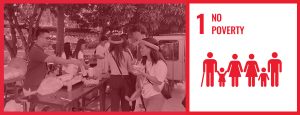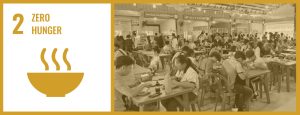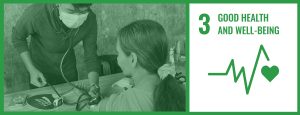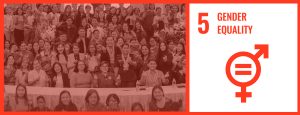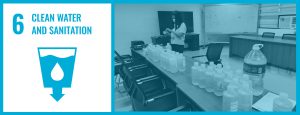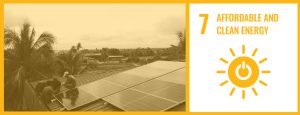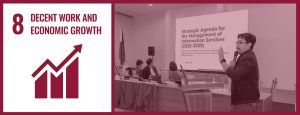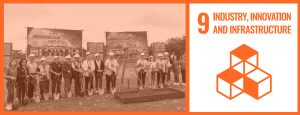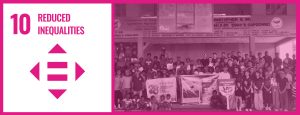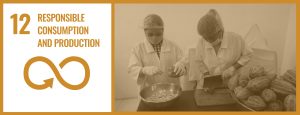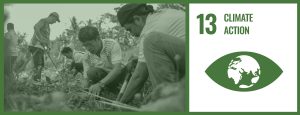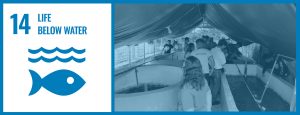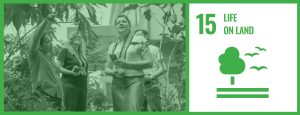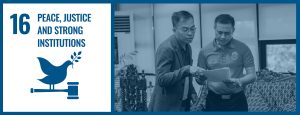2024 Research | SDG 9 – Industry, Innovation and Infrastructure
Research Programs
Design, Development and Manufacture of Low-Cost Mechanical Seeder for Rice Production
Proponents: Raphy A. Sugue, Joel V. Pangangaan
Abstract
The project was conceptualized based from farming experiences on manually broadcasted and direct seeded rice. For cost-effective farming operation, the machine was designed through the Sketch-Up Application and fabricated manually through the aid of a welding machine, tools, and equipment. The machine was made up of iron bars, G.I. pipes, and polymers. It is composed of a boom paired with an axle in which eight pairs of seed pockets are attached. It has 2 cage wheels supported with pillow block bearings. The right-side cage wheel is a free-wheel that serves as support for balance operation. Sprocket with a chain is attached to the axle-shaft connecting to a smaller sprocket connected to a horizontal rod purposely to paddle the grains inside the container by a vertical rod attached from the horizontal rod. It has an eight seed container for the germinated seeds made of transparent mineral water polymer. The seeder is provided with a floater made of leaf spring so as not to get stuck into the mud. It is provided with a 2″x4″x6′ lumber that serves as paddy planer before the seeds drop and a shoe-like plow in the middle to construct a canal for excess water. The specification of the machine includes the width of 190 cm, length of 140 cm, and height of 70 cm. effective width where seeds will be dropped is 140 cm composed of eight compartments with equal distance of 20 cm. Based on the calibration of the machine for a 1.4 m by 3.0 m (4.2 sq.m.) area, 3 tests had been made. For hybrid seed (dry basis), the machine dropped 21 grams (Test 1), 22 grams (Test 2), and 23 grams (Test 3). Considering the average test, the 22 grams of seeds distributed in a 1.5 m width by 3.0 m length is equivalent to 52.38 kilograms per hectare. For inbred seed (dry basis), the same test was made and average distributed seed in a 4.2 sq.m. was 30 grams, equivalent to 71.43 kilograms per hectare. For the time-efficiency test, average velocity of operation was 3 km per hour considering all other time-consuming activities. Considering the effective width of the machine, a one-hectare of operation can finish within 2.38 hours. For the cost-effective operation compared to transplanted rice, one-day operation of two laborers, the machine can accomplish 3.36 hectares with a labor cost of Php 1,500.00 compared to Php 8,000.00 to Php 10,000.00 per hectare straight contract (pakyaw with and without snacks).
More than ISU CBAPA’s KSA? Designing Faculty Researchers’ Quality Professional Development Prospective Framework for Sustainable Improvement in Research Engagement Study:Knowledge of Institutional Research Ecosystem
Proponents: Ralliegh F. Vizcarra, Amie P. Bala, Jayson G. Gollayan, Mariflor M. Devibar
Abstract
This study investigates the factors influencing research engagement among faculty members at the College of Business, Accountancy, and Public Administration (CBAPA) at Isabela State University (ISU). It highlights the significance of faculty involvement in research for professional development and improved educational quality. Utilizing a mixed-methods approach, the research identifies critical knowledge areas necessary for effective research practices, including critical thinking, diverse methodologies, and grant writing skills. Participants reported limited awareness of institutional resources and funding opportunities, indicating a pressing need for enhanced communication and support. The findings reveal that only 28.4% of faculty were fully aware of available insitutional resources, underscoring gaps in knowledge that hinder research productivity. The study proposes a framework aimed at fostering a strong research culture within CBAPA, emphasizing the integration of teaching and research as essential for academic excellence. By addressing these gaps through targeted outreach and training initiatives, the instituions can empower faculty researchers to maximize their initiatives, the institution can empowe faculty researchers to maximize their potential, ultimately contributing to sustainable growth and enhanced academic standing.
More than ISU CBAPA’s KSA? Designing Faculty Researchers’ Quality Professional Development Prospective Framework for Sustainable Improvement in Research Engagement Study:Research Core Knowledge, Technical and Soft Skills
Proponents: Ralliegh F. Vizcarra, Rolly L. San Jose, Meryl Pearl L, Facun, Mariflor M. Devibar
Abstract
This study explores the critical need for a structured professional development (PD) framework aimed at enhancing the core knowledge, technical skills, and soft skills of faculty researchers at Isabela State University College of Business, Accountancy, and Public Administration (ISU CBAPA). Findings reveal that while faculty members possess moderate knowledge of research methods, significant gaps exist in areas such as data collection, ethical practices, data analysis techniques, and publishing strategies. The research emphasizes the importance of integrating both technical and soft skills in PD initiatives to foster a culture of research excellence. By employing a mixed-methods approach, including qualitative descriptive and thematic analysis, the study identifies key areas for improvement and proposes targeted training programs to enhance faculty competencies. Ultimately, investigating in comprehensive PD initiatives is esential for empowering faculty to conduct high-quality research and effectoivley disseminate their findings.This aligns with existing literature that underscores the positive impact of holistic faculty development on research engagement and productivity. The proposed framework aims to cultivate a stronger academic culture at ISU CBAPA, thereby enhancing the overall impact of scholarly contributions.
More than ISU CBAPA’s KSA? Designing Faculty Researchers’ Quality Professional Development Prospective Framework for Sustainable Improvement in Research Engagement Study:Attitudinal Traits, Institutional Supports & Challenges
Proponents: Ralliegh F. Vizcarra, Jessica C. Managuelod, Jeanette Gonzales
Abstract
This study explores the essential knowledge areas and professional developmenyt (PD) needs of faculty researchers at ISU CBAPA to enhance their research engagement and productivity. Five key themes emerged: critical thinking and diverse methodologies, proficiency in quantitative and qualitative analysis, effective communication and collaboration, continual learning, and grant writing skills. Additionally, the research highlights the importance of understanding the organizational research structure, funding opportunities, and fostering a supportive research culture. Findings indicate that while faculty exhibit moderate knowledge in research methods, gaps exist in areas such as data collection, ethical practices, and publishing processes. The results underscore the necessity for a comprehensive PD framework that includes targeted training sessions, mentorship opportunities, and resource accessibility to empower faculty researchers. By addressing theses gaps, ISU CBAPA can cultivate a more robust research environment that promotes collaboration, innovation, and effective dissemination of research findings.
“From Orchard to Bottle: Exploring the Potential of Locally Available Fruits for Sustainable Wine Production and Indigenous Vegetables for Mixed Juice Drink”
Proponent: Honeylyn D. Farala
Abstract
Fruits and vegetable are recognized as fundamental source of nutrients. The research study was conducted to determine the acceptability, marketability and nutritive value of locally fruit wine and mixed juice drink. The 9-point hedonic scale and 7-point hedonic scale was used to determine the acceptability level of mixed juice drink of wines and 5-point Likert scale for marketability of the wine and juice.
The analyzation results of one-way classification of the Analysis of variance (ANOVA) showed that pomelo wine has a grand weighted mean ranging from 6.68 to 6.80, The turnip wine 6.74 to 6.75, mango wine showed varied ratings in which food experts (grand weighted mean = 6.51) and community people (6.50) and FSM students (6.36). The pineapple wine, has grand weighted mean score ranging from 6.61 to 6.74. This indicates that all the wines are acceptable in three group of respondents. Lastly, for the pipino wine, it received the lowest rating in which it received a rating ranging from 5.99 to 6.36 categorized as only acceptable. For mixed juice drink receives very acceptable in terms of appearance, color, aroma, and taste and extremely acceptable in terms of texture. For the marketability of the study, it is revealed that it has very high potential in the market.
“Nutritive Values of Slender Amaranth and Lemon Grass with Philippine Lime”
Proponent: Honeylyn D. Farala
Abstract
The study aimed to determine the nutritive value and shelf life of slender amaranth, lemon grass and Philippine lime aqueous extract mixed juice drink. The product consisted of three treatments, treatment 1: 150 grams of slender amaranth, 100 grams of lemon grass and 200 grams Philippine lime; treatment 2: 100 grams of slender amaranth, 150 grams lemon grass, 200 grams Philippine lime; and treatment 3: 50 grams of slender amaranth, 200 grams of lemon grass, 200 grams Philippine lime. The nutritional value of the study underwent a process and assessment conducted by the Department of Science and Technology (DOST) III and found out that there are ________________________. The study revealed that mixed juice drinks stored at room temperature have a longer shelf life. The study showed that the mixed juice drink has market potential.
“Marketability of Slender Amaranth and Lemon Grass with Philippine Lime”
Proponent: MACARIO Q. TAMUNDONG JR.
Abstract
The study aimed to determine the marketability of Slender Amaranth and Lemon Grass with Philippine Lime. The product consisted of slender amaranth, lemongrass, and Philippine lime with different formulation. The descriptive – experimental method of research was used with the survey questionnaire as the main data gathering instrument. The study used five-point Likert rating scale to evaluate the marketability. The statistical tools used in the study were weighted mean and ANOVA. The findings indicate that all treatments are perceived positively across the respondent groups. However, there are no statistically significant differences in consumer demand, supply availability, or production costs among the three treatments, as all p-values exceed the conventional threshold of 0.05. Lastly, the treatment 3 being the most favored formulation due to its higher mean scores across all evaluation criteria.
“A Bite of Goodness: Nutritive Values and Shelf Life of Coconut Curd (Latik) Macaroons”
Proponents: MACARIO Q. TAMUNDONG JR., Honeylyn D. Farala
Abstract
The study aimed to determine the nutritive value and shelf life of coconut curd (latik) macaroons. The product consisted of 250 grams, 375 grams and 500 grams proportions of macaroons with coconut curd. The nutritional value of the study underwent a process and assessment conducted by the Department of Science and Technology (DOST) III and found out that there are __________________. The study revealed that mixed juice drinks stored at room temperature have a longer shelf life. The study showed that coconut curd macaroons are acceptable and have market potential.
“Application of simple nutrient plus vermi tea on high-value crops for NFT hydroponics system under controlled climatic condition.”
Proponents: Franklin A. Samonte, Marion Caraui, Mark Joseph Reyes
Abstract
Application of simple nutrient plus vermi tea on high-value crops for NFT hydroponics system under controlled climatic condition.
Based from the result of the research study, the develop hydroponics system was feasible to design and develop a small-scale hydroponics system every locally and commercially available materials. The respondents concur and accept the design and construction, aesthetic, technical operation, relevance of the study of small-scale hydroponics system. Application of simple nutrient plus vermi tea 75 % and 100 % were enhanced the growth and development of lettuce as manifested on the yield per plant.1 The return of investment was obtained in the due to low electricity consumption and the production lettuce under develop hydroponics applied with Simple Nutrient plus Vermitea was obtained in T2 – 100 % of SNAP + Vermitea = 295.60%.
Empowering Communities: Design,Fabrication, and Evaluation of Mobile Solar-Powered Charging Stations with Integrated Street Lighting and Automated Water Refilling Station for Disaster Resilience
Proponents: Jolan Baccay Sy, Jake La Madrid, Allen M. Paz
Abstract
This study investigates the design, fabrication, and evaluation of mobile solar-powered charging stations integrated with street lighting and automated water refilling systems, aimed at enhancing disaster resilience in rural communities, particularly at the Cabagan Riverside Evacuation Center. The primary objectives were to address energy and water accessibility challenges during natural disasters, develop functional designs for diverse community needs, and utilize sustainable materials for durability.
The innovative approach combines solar-powered charging, street lighting, and automated water refilling into a single mobile unit. Engineered to provide essential energy, lighting, and water access for one week in disaster-affected areas, the station features a lightweight frame, high-efficiency solar panels (330 watts), and a 100Ah battery. Multiple USB ports facilitate device charging, while integrated LED lighting enhances nighttime safety. The automated water refilling system employs ultrasonic sensors and an Arduino microcontroller for efficient water dispensing. Evaluation through a structured questionnaire revealed significant improvements in energy access and safety, with high satisfaction among community members. This study underscores the potential of solar-powered solutions to strengthen disaster resilience and promote sustainability in vulnerable regions, offering valuable insights for policymakers and practitioners in disaster management.
Development of an Automated Solar (Autosolar)Powered Biowaste Processing Machine
Proponents: Michelle Ann M. Calubaquib,Ph.D., Engr. Jolan B. Sy, Engr. Jake D. La Madrid, Engr. Samuel R. Simon, Ambrose Hans G. Aggabao, Ph.D.
Abstract
This research focused on the design, optimization, and integration of a biowaste processing machine, or biodigester, and a 16 kW solar photovoltaic (PV) system to create a sustainable and efficient solution for converting agroforestry waste into compost. The biodigester operates through aerobic decomposition, utilizing a control system that monitors and regulates temperature, humidity, and soil moisture to ensure efficient compost production. This system includes sensors, a microcontroller, and a Human-Machine Interface (HMI) for real-time monitoring and control. The mobile 16 kW solar PV system, comprising 18 high-efficiency monocrystalline panels, converts sunlight into electricity, which is then optimized and stored using a Deye inverter and a high-capacity lithium battery managed by a Battery Management System (BMS) and active balancer.
The successful integration of the biodigester and solar PV system resulted in a mobile biowaste processing unit capable of converting agroforestry wastes into organic fertilizers. The system’s mobility, flexibility, and reliance on solar energy ensured efficient and sustainable operation. Key findings included the production of compost with significant nutrient content (1.68% nitrogen, 0.14% phosphorus, 2.16% potassium, pH 7.12) when using a compost activator, maturing in 20 days. Compost without the activator had higher nitrogen and phosphorus but lower potassium content, maturing in 25 days. This study highlights the benefits of integrating renewable energy with biowaste processing technologies, promoting sustainable agricultural practices and reducing environmental impact.
BotCoin: Bottle-Coin Vendind Machine
Proponents: Kelvin Kris C. Gonzales, Alvin B. Tañeza
Abstract
BotCoin: Bottle-to-Coin Vending Machine is a technological solution designed to alleviate the growing issue of plastic and can waste in San Mateo, Isabela, Philippines. This clever vending machine converts throwaway bottles/cans into cash, encouraging residents to recycle and promoting environmentally friendly activities. BotCoin aims to make recycling more accessible and engaging by combining technology and financial incentives, particularly among younger generations who are more likely to respond to tech-based solutions.
However, numerous challenges and issues have emerged in waste segregation practices in many communities. In recent years, local government has noticed an alarming rise of plastic bottles/cans garbage in public places, rivers, and landfills. Despite various environmental awareness programs, plastic recycling rates are still low, and inappropriate disposal contributes to environmental damage. Furthermore, the lack of a formal waste management system and readily available recycling programs makes it difficult for residents to actively participate in plastic trash reduction.
The increasing prevalence of plastic bottles and cans in the Philippines, despite existing waste management policies, highlights a significant challenge in environmental sustainability. The country is grappling with a substantial volume of plastic waste, with Quezon City alone generating approximately 262 tons of plastic waste daily, indicative of broader national trends (Sidhu et al., 2021). The Philippines ranks as the third-largest contributor to global mismanaged plastic waste, following China and Indonesia, which underscores the urgency of addressing this issue through effective waste management strategies (Deocaris et al., 2019). Despite the enactment of the Ecological Solid Waste Management Act of 2000 (Republic Act 9003), which aims to enhance waste management practices, the effectiveness of these policies remains questionable. A study indicates that the lack of public awareness and inconsistent policy implementation are critical barriers to successful waste management (Chen et al., 2021).
With this, the BotCoin vending machine provides a localized, small-scale solution that is both inexpensive and feasible for rural areas such as San Mateo, Isabela. This innovation also addressed the gaps to other researches on incentivized recycling systems in developing countries, where economic and infrastructure constraints frequently impede effective waste management techniques. This also represents a transformative approach to recycling and waste management, aligning individual and collective interests. It empowers individuals to contribute to a sustainable future while earning rewards for their actions. As more of these innovative machines will soon populate our towns/cities, we can look forward to a world where recycling pays dividends for both our wallets and our planet, making the Earth greener and wealthier, one recyclable at a time.
Enhancing the Basic Services on the Implementation of Sustainable Development Goals: The Municipality of San Mateo Case
Proponents: Rosalie C. Leal, Venus A. Diego
Abstract
The paper examines the role of Local Government Units (LGUs) in providing quality basic services in accordance with the United Nations’ Sustainable Development Goals (SDGs), specifically in the municipality of San Mateo, Isabela. The study seeks to confirm their accomplishments by evaluating the execution of fundamental services in accordance with the Sustainable Development Goals (SDGs). It concentrates on certain Sustainable Development Goals associated with agriculture, infrastructure, health, environmental management, tourism, education, and social services, highlighting the interaction between political and governance frameworks.
The study evaluates fundamental services, the integration of Sustainable Development Goals (SDGs), levels of satisfaction, and disparities among respondent groups, while proposing improvement initiatives. Results indicate significant integration and favorable evaluations, demonstrating a dedication to global sustainability. San Mateo’s distinguished status and multiple accolades highlight its dedication to the Sustainable Development Goals (SDGs). This research concludes that San Mateo delivers services equally, emphasizing inclusivity and equality. The affirmative association between integration and satisfaction underscores the significance of aligning services with sustainable development concepts. Recommendations encompass ongoing enhancement, needs assessments, periodic evaluations, community satisfaction surveys, adaptive action plans, and a specialized monitoring division. The study adds to what is known about sustainable development in local government by showing how integration, satisfaction, and the success of implementing the SDGs in LGU San Mateo are all connected.
UAV-Based Corn Health Recognition Model Using Enhanced Threshold-Based Segmentation for Corn Plantation
Proponent: Dr. Joel M. Gumiran
Abstract
Phenotyping plays a vital role in assessing the health traits of a plant. However, the process can become tedious, and labor-intensive, especially when applied in a wide range of applications. Hence, an Unmanned Aerial Vehicle or UAV has been utilized due to its user-friendliness, high-resolution capabilities, and cost-effectiveness. Despite their advantages, UAV phenotyping segmentation faces several challenges that can hinder the segmentation process and negatively impact recognition accuracy.
Thus, an Enhanced Threshold-based Segmentation technique has been implemented, which normalizes image luminosity, and improves both segmentation and recognition accuracy. Additionally, template matching was employed during the recognition phase, achieving perfect correlation when the Normalized Cross-Correlation (NCC) equals 1. Following normalization of the images, recognition accuracy improved by 5.25 percent, reaching an impressive 98.07 percent recognition accuracy at a distance of 4 meters. This advancement allows for more precise identification of unhealthy leaves, providing significant benefits to farmers and agriculturists by reducing time, effort, and costs associated with crop management.
Designing and Construction of Posture Brace Integrating Backpack Functionality
Proponent: Ronald B. Isidro Jr
Abstract
This paper explores the design and construction of a posture brace with integrated backpack functionality. The device is intended to correct posture and reduce the risk of back pain while also serving as a functional, everyday backpack. This dual-purpose solution is aimed at students and professionals who carry heavy loads, seeking to improve spinal alignment and reduce the strain on muscles. Prototyping and testing demonstrate that this design offers significant ergonomic advantages over traditional backpacks.
Design and Production of Abdominal Brace Contraption Merged with the Function of Utility Apparel
Proponent: Ronald B. Isidro Jr
Abstract
The researcher explored the design and production of an abdominal brace integrated with utility apparel functionality. The aim of the research is to create a contraption that not only provides abdominal support but also incorporates practical storage solutions, enhancing convenience for users who require additional physical support. Prototyping and evaluation of the product indicate the potential of such hybrid designs to improve both health and productivity in daily life.
Designing a User-Centered Gym Bag: Functionality and Hygiene Solutions for Active Individuals
Proponent: Dr. Sheryl D. Tomas
Abstract
This study investigates the design and creation of a versatile gym bag, employing Tim Brown’s Design Thinking technique to meet the particular requirements of fitness enthusiasts. This study highlights the significance of developing eco-friendly products that resonate with customer values, amid the growing emphasis on sustainability in the fitness industry. Utilizing user-centered research with 20 participants, essential features were discerned, such as hygiene, organization, and functionality. The design incorporates a vented compartment for moist garments, a waterproof shoe pocket, and specific storage for lifting gloves and personal goods, hence improving cleanliness and user experience. Participants’ feedback affirmed the efficacy of these treatments, emphasizing the bag’s contribution to hygiene and convenience while exercising. Furthermore, utilizing locally woven handloom fabrics as sustainable materials not only reduces environmental effect but also bolsters local weavers, promoting economic development within their communities. This study enhances the promotion of sustainability in product design, demonstrating how intentional design may satisfy customer needs while fulfilling wider social obligations. This research’s gym bag exemplifies a prototype for future advancements in the fitness industry, demonstrating the capacity of design thinking to produce functional, visually appealing, and socially responsible products.
Developing a Tool-Ready Carpenters’ Bag: Safety, Efficiency, and Durability in the Field
Proponent: Dr. Sheryl D. Tomas
Abstract
This study examines the design and creation of a carpenter’s bag, utilizing Tim Brown’s Design Thinking process as the foundational framework. The project aims to develop a functional and ergonomic backpack specifically designed for carpenters, acknowledging the distinct obstacles they encounter in challenging situations that necessitate mobility and safety. Insights were obtained from carpenters concerning their needs for tool organization, accessibility, and safety through a sequence of user-centered phases: empathize, define, ideate, prototype, and test. Identified key characteristics were a harness hook for secure attachment during climbing, hands-free movement, and compartments for convenient access to vital tools.
Although the original aim was to employ indigenous handloom fabrics to enhance local craftsmanship, the research encountered considerable obstacles related to the material’s durability and safety standards. As a result, the advancement of the bag prototype was halted to emphasize practical integrity over aesthetic considerations. This decision highlights the imperative for cooperation among designers, textile manufacturers, and artisans to develop materials that comply with contemporary safety standards while respecting cultural history. This study underscores the necessity of incorporating user feedback into product design and advocates for ongoing investigation of sustainable solutions that bolster the local textile industry while meeting the practical requirements of experts in the sector.

